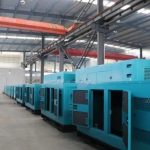Introduction
Diesel generators play a crucial role in providing backup power in various industries, commercial establishments, and residential settings. However, the widespread use of diesel generators raises concerns about their environmental impact. In recent years, environmental standards and regulations have become increasingly stringent in an effort to reduce harmful emissions and protect the environment. This article aims to explore the environmental impact of diesel generators and the measures taken to ensure compliance with environmental standards.
Environmental Impact of Diesel Generators

1. Emissions
One of the primary environmental concerns associated with diesel generators is the emission of pollutants into the atmosphere. Diesel generators produce a range of harmful emissions, including nitrogen oxides (NOx), particulate matter (PM), sulfur dioxide (SO2), and carbon monoxide (CO). These pollutants can have a significant impact on air quality and human health, contributing to respiratory problems, cardiovascular diseases, and other health issues.
2. Greenhouse Gas Emissions
In addition to conventional pollutants, diesel generators also emit greenhouse gases such as carbon dioxide (CO2) and methane (CH4). These gases contribute to global warming and climate change, posing a threat to the environment and biodiversity. The combustion of diesel fuel releases carbon dioxide, a major greenhouse gas that traps heat in the atmosphere and contributes to the warming of the planet.
3. Noise Pollution
Apart from air emissions, diesel generators are also a significant source of noise pollution. The operation of diesel generators can generate high levels of noise, disrupting the surrounding environment and causing nuisance to nearby residents. Noise pollution can have adverse effects on human health, including sleep disturbances, stress, and hearing loss.
Environmental Standards for Diesel Generators
1. Emission Limits
To address the environmental impact of diesel generators, regulatory authorities have set stringent emission limits for various pollutants. These limits specify the maximum allowable concentrations of pollutants that can be emitted by diesel generators during operation. Emission standards vary by region and are regularly updated to reflect advances in technology and scientific knowledge.
2. Tier Ratings
One of the key mechanisms for regulating emissions from diesel generators is the use of tier ratings. Tier ratings are a system of emission standards established by the U.S. Environmental Protection Agency (EPA) to categorize diesel engines based on their emissions performance. The tier system ranges from Tier 1 (least stringent) to Tier 4 (most stringent), with each tier imposing stricter limits on emissions of NOx, PM, and other pollutants.
3. find out this here (SCR) Systems
Selective Catalytic Reduction (SCR) systems are advanced emission control technologies used to reduce NOx emissions from diesel generators. SCR systems work by injecting a urea-based solution into the exhaust stream, where it reacts with NOx to form harmless nitrogen and water vapor. By installing SCR systems, diesel generator operators can achieve compliance with stringent emission standards and reduce their environmental footprint.
4. Diesel Particulate Filters (DPF)
Diesel Particulate Filters (DPF) are another effective technology for controlling emissions from diesel generators. DPFs trap and remove particulate matter (PM) from the exhaust stream, reducing the emission of harmful particles into the atmosphere. DPFs are widely used in modern diesel engines to meet stringent emission standards and improve air quality.
5. Fuel Quality Standards
In addition to emission controls, fuel quality standards also play a crucial role in reducing the environmental impact of diesel generators. High-quality diesel fuel with low sulfur content can help minimize emissions of sulfur dioxide (SO2) and particulate matter, leading to cleaner combustion and lower environmental impact. Compliance with fuel quality standards is essential for maintaining the efficiency and environmental performance of diesel generators.
6. Noise Control Measures
To address noise pollution from diesel generators, operators can implement various noise control measures. These measures may include installing sound-attenuating enclosures, using noise barriers or baffles, and conducting regular maintenance to minimize noise emissions. By adopting noise control measures, diesel generator operators can mitigate the impact of noise pollution on the environment and surrounding communities.
Conclusion
Diesel generators are essential for providing reliable backup power in various applications, but their environmental impact must be carefully managed to protect the environment and public health. By complying with stringent emission standards, implementing advanced emission control technologies, and adopting sound environmental practices, diesel generator operators can minimize their environmental footprint and contribute to a cleaner and healthier planet. As environmental regulations continue to evolve, it is crucial for stakeholders to stay informed and proactive in addressing the environmental challenges associated with diesel generators.
